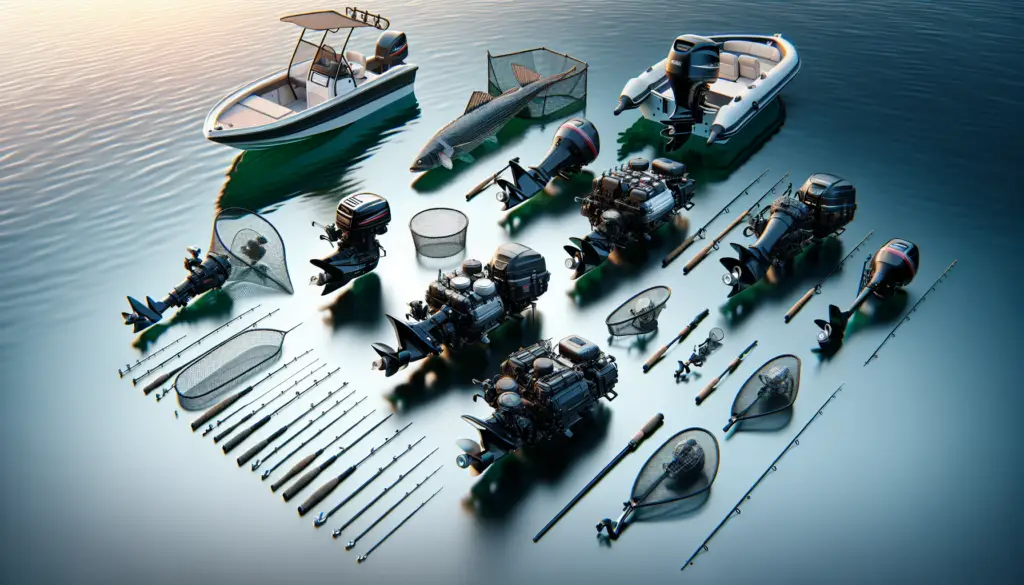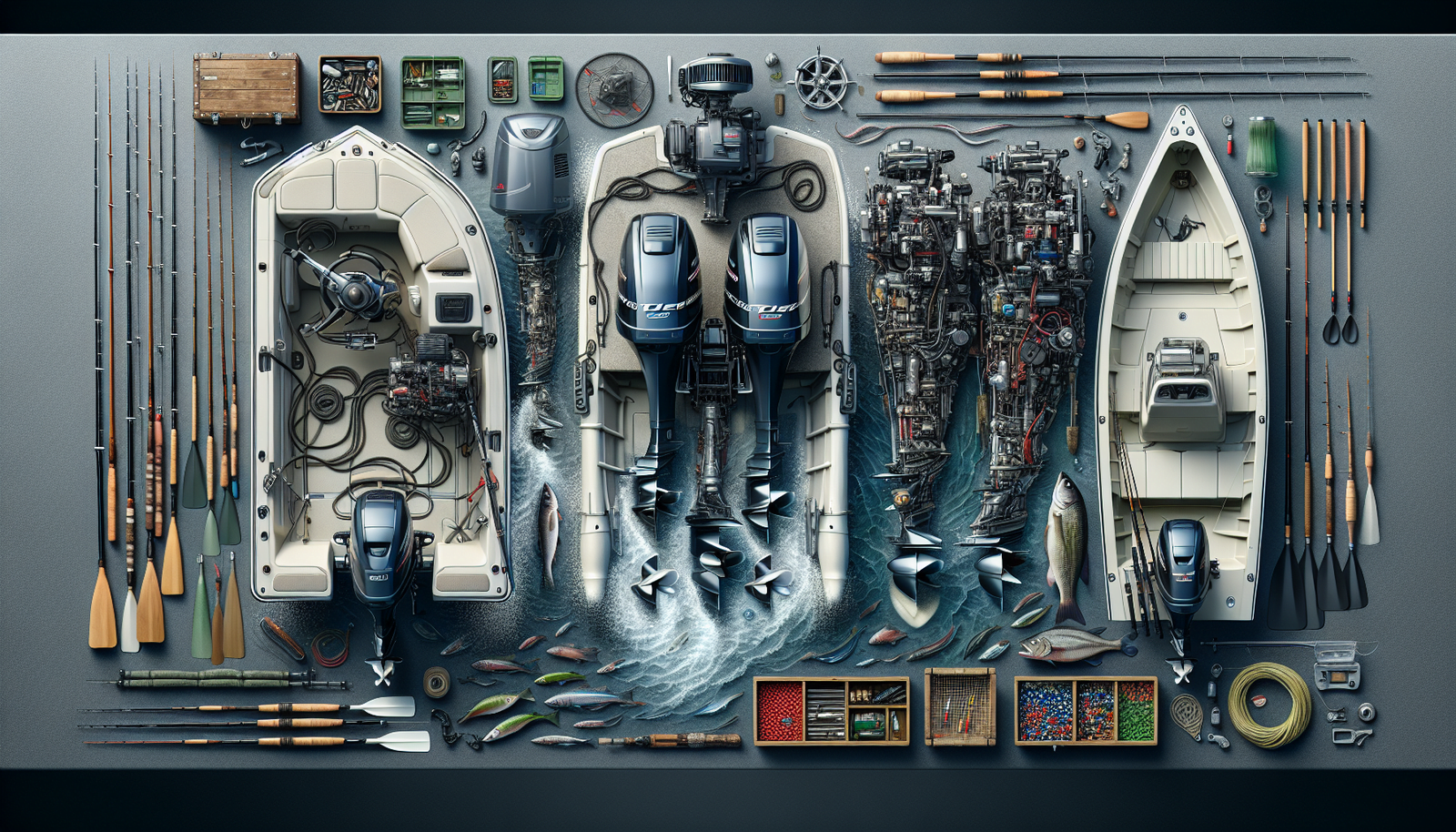Imagine you’re out on the glistening water, the morning sun illuminating the ripples around your boat. All is still except for the soft hum of your engine. You’ve got your fishing gear, your bait and your trusty pole. Now, all you need is the know-how to use them effectively. With “Most Popular Fishing Techniques for Different Boat Engines,” you’re about to learn clever strategies for maximizing your catch based on the kind of boat engine you’re using. Whether you’re cruising with an outboard motor or navigating with an inboard diesel, each engine type brings unique challenges and opportunities on the water.

Understanding Different Boat Engines
Brief history of outboard motors
Outboard motors have a historical significance that is quite intriguing. Their invention dates back to the early 20th century, when Ole Evinrude, a Norwegian immigrant, invented the first commercially viable outboard engine in 1909. Since then, these engines have come a long way, from their simple, manually cranked designs to today’s high-performance, technologically advanced versions.
Differentiating inboard and outboard engines
You may wonder, what’s the difference between inboard and outboard engines? Simply put, an outboard engine is a self-contained unit that includes engine, gearbox, and propeller, located outside the hull of the boat. On the other hand, an inboard engine is situated inside the boat’s hull, with a drive shaft that runs through the hull to the propeller. Both have their personal merits and downsides, with a significant factor being how you plan to use your boat.
Kinds of boat engines and their usage
There are several types of boat engines, each appropriate for different boating needs. These include outboard motors, inboard motors, stern drives, jet drives, and electric drives. Outboard motors are highly versatile, suitable for everything from fishing boats to high-speed performance boats. Inboard motors provide more cabin space on a boat and are preferable for larger boats. Stern drives combine features of both inboard and outboard motors. Jet drives push water out the back of the boat for propulsion and are great for shallow waters. Lastly, electric drives are eco-friendly and offer silent operation, perfect for calm waters and quiet fishing escapades.
Trolling Fishing Technique
Understanding trolling technique
Trolling is a popular and effective fishing technique that involves moving your boat slowly over a body of water, with fishing lines trailing behind. The aim is to simulate the movement of fish prey to entice predator fish.
Ideal boat engines for trolling
Trolling demands a boat engine that can maintain slow, steady speeds. Outboard motors are often the go-to choice for trolling because they allow for precise speed control and maneuverability. They also have the advantage of being quieter, which helps in not scaring away fish.
Equipments needed for trolling technique
A successful trolling expedition requires equipment like rod holders, downriggers, and, of course, the right fishing rods and lures. Downriggers allow you to keep your bait at a specific depth, while rod holders aid you in managing multiple fishing lines at once.
Advantages and disadvantages of Trolling
Trolling’s primary advantage is its effectiveness. By moving around, you cover more ground and increase your chances of locating fish. However, it does consume more fuel than other fishing methods since you’re constantly on the move. Also, trolling gear can be quite expensive.
Drift Fishing Technique
Principles of drift fishing
Drift fishing is the art of fishing where the boat is allowed to drift with the current or wind. The technique is extensively used in offshore fishing and is quite effective for targeting species that inhabit the bottom waters.
Best boat engines for drift fishing
The choice of a boat engine for drift fishing isn’t heavily critical as you’re essentially being carried by the currents or wind. However, an engine that gives you good maneuverability, like an outboard motor, can help you position your boat optimally for the drift.
Equipment required for drift fishing
Drift fishing requires basic fishing gear like a strong, flexible fishing rod, bait, and sinkers. Weighted lines or drift socks could be used where you want to slow down your drift or control your drift direction.
Strengths and weaknesses of Drift fishing
Drift fishing’s strength lies in its simplicity and effectiveness, especially in offshore settings. It’s quiet, uses less fuel, and ups your chances of a catch by presenting the bait more naturally. But, it’s not recommended in crowded areas due to the risk of collision. Weather conditions also significantly influence your drift speed.
Still Fishing Technique
Definition of still fishing technique
Still fishing, as the name suggests, involves fishing from a stationary position. One could fish from the shore, a dock, or an anchored boat. Baited lines are dropped into the water and patiently awaited for fish to bite.
Suitable boat engines for still fishing
The type of boat engine isn’t really crucial for still fishing as the boat is anchored. You just need an engine reliable enough to get you to your chosen spot and back.
Equipment for still fishing
For still fishing, traditional fishing poles, bait, fishing line, and sinkers are all that’s required. Staying stationary, you may also want to invest in comfortable seating!
Pros and cons of Still fishing
Still fishing is the simplest form of fishing, making it great for beginners and kids. It’s peaceful, uses very little equipment, and you get to enjoy nature while waiting for a bite. On the downside, it’s a slow process and limits how many fish you can potentially reach.

Fly Fishing Technique
Understanding fly fishing technique
Fly fishing is a specialized fishing technique where you use an artificial ‘fly’ as bait, intended to mimic real flies or other prey. A specially weighted line is used, and bait is cast using a particular whipping motion.
Best boat engines for fly fishing
Fly fishing is frequently carried out in rivers or streams, where large boat engines aren’t necessary. However, on occasions where larger water bodies are involved, a quiet, low horsepower outboard or an electric motor is preferred to avoid alarming the fish.
Essential equipment for fly fishing
Fly fishing requires specific gear like a fly rod, fly line, tapered leader, and flies. A net is also helpful for landing fish once they’re hooked.
Advantages and disadvantages of Fly fishing
Fly fishing is an active, rewarding technique that allows for repeated casting and retrieval of the lure. It feels technical and sporty, adding thrill to the fishing experience. However, it does have a steep learning curve and requires specialized, often expensive, equipment.
Bottom Fishing Technique
Working principles of bottom fishing
Bottom fishing targets fish that dwell along the sea or lake bottom. As the name indicates, weights are used to sink your baited hook to the bottom in hope of attracting a bite.
Boat engines suitable for bottom fishing
For bottom fishing offshore, larger boats equipped with powerful inboard engines or stern drives are a good choice. But for smaller bodies of water, simple outboard engines are sufficient.
Required equipment for bottom fishing
Weighted fishing lines, sharp hooks, robust rods, and bait are essential for bottom fishing. The advent of fish finders or echo-sounders has made locating the bottom-dwelling species significantly easier.
Strengths and weaknesses of Bottom fishing
This technique allows you to catch a wider variety of fish species, some of which could be quite large and exciting. However, you may also catch unwanted species, and retrieving your hook can be a challenge if it gets snagged on the bottom.
Jigging Fishing Technique
Concept of jigging fishing
Jigging involves casting out a jig and letting it sink to the desired level in the water column. Once the jig has sunk, it’s then vertically jigged or moved up and down in a jerky motion to attract fish.
Ideal boat engines for jigging fishing
Inshore jigging often makes use of small to medium-sized boats that can be handled well with outboard engines. When jigging offshore, larger boats powered by inboard engines or stern drives are typically used.
Equipment necessary for jigging fishing
In addition to your standard fishing gear, you’ll obviously need some jigs – weighted lures with a hook molded into them. These can be decorated with feathers, hairs, or plastic grub to attract fish.
Pro and cons of Jigging fishing
Jigging can be very productive as it allows you to fish at varied depths and attract different species. But, it can be physically demanding to jig for extended periods, and getting your jig’s depth right requires some practice.
Hand Gathering Technique
Understanding hand gathering technique
Hand gathering, as the title implies, is a collection of traditional fishing techniques that involve catching fish directly by hand. This includes noodling, flounder tramping, and pearl diving, among others.
Suitable boat engines for hand gathering
Often, hand gathering methods don’t necessitate a boat at all. But when a boat is used, any reliable engine is suitable.
Tools required for hand gathering
Tools for hand gathering vary greatly depending on the specific method used. For noodling, you might require gloves to protect your hands. For pearl diving, you’ll need diving equipment.
Advantages and disadvantages of Hand gathering
Hand gathering offers a close, exciting connection with nature and can feel highly satisfying. On the flip side, it can be dangerous, not to mention it is illegal in some places.
Cast Netting Fishing Technique
Basics of cast netting fishing
Cast netting involves throwing a circular net with small weights on the edges over a school of fish or bait fish. When the net is pulled in, it closes at the bottom, trapping fish inside.
Best boat engines for cast netting fishing
Generally, small skiffs, johnboats, or canoes are used for casting nets, powered by small outboard engines or occasionally just paddles.
Equipment needed for cast netting fishing
A properly constructed casting net is the main piece of equipment needed. It’s also handy to have a bucket to store your catch and gloves to protect your hands while throwing and retrieving the net.
Strengths and weaknesses of Cast netting fishing
Cast netting can yield a large catch quickly and is excellent for catching bait fish. However, learning to throw the net correctly can take a lot of practice, and in some localities, a specific license is required to use a casting net.
Maintaining Boat Engines for Efficient Fishing
Importance of regular boat engine maintenance
Regular engine maintenance is key in ensuring your boat engine runs efficiently for fishing trips for years to come. It lessens the probability of unwanted breakdowns and extends the life of your engine.
General tips for maintaining boat engines
Routine engine maintenance includes changing the oil, replacing the fuel filter, inspecting the propeller, monitoring the cooling system, and always checking for corrosion. Always consult your user manual for the manufacturer’s maintenance recommendations.
How to diagnose common boat engine problems
Common boat engine troubles often include hard starting, poor performance, and overheating. These can usually be traced back to issues with fuel, ignition, or engine temperature regulation. Remember, regular preventive maintenance is the best way to keep engine problems at bay.
Methods to increase boat engine longevity
To extend your boat engine’s life, always warm-up your engine before taking off, use the right fuel and oil as recommended by the manufacturer, and don’t overload your boat. Ensure you store your boat properly during off-seasons or prolonged periods of non-use. Consider using fogging oil for internal engine preservation and always keep your boat covered up.

